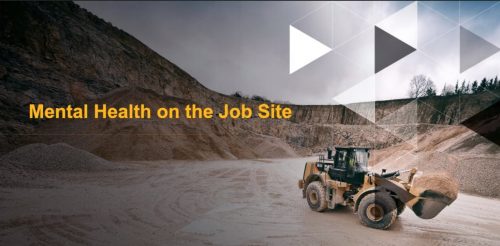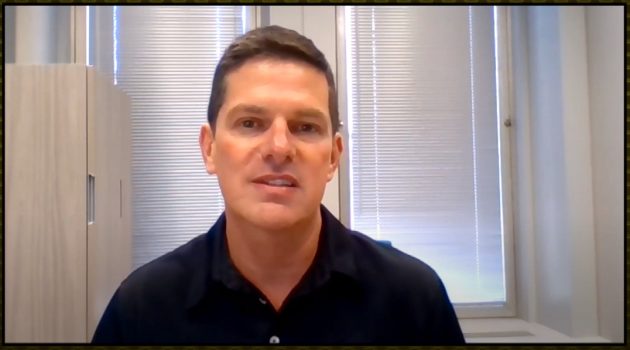
Features
Education
Caterpillar makes mental health a part of workplace conversation
A 2016 study ranked suicide death by occupation, and construction ranked at the top
August 20, 2020 By Jay Koblun

Caterpillar has decided that mental health and wellness in construction is not a topic that can be ignored any longer.
Mental wellness is an often-overlooked, but critically important element of workplace safety. Workers who are struggling with depression and anxiety are more likely to be involved in incidents that harm themselves or others. Caterpillar doctor John Pompe and Michelle Walker from Construction Alliance for Suicide Prevention discussed risk factors in the industry, warning signs that an employee may be struggling, and actions employers and managers can take to help in a mental health awareness webinar held in mid-July.
“In 2016 the CDC released a study that ranked suicide death by occupation, and construction ranked at the top of that list,” said Walker. “Construction is the industry with the highest level of suicide.”

Michelle Walker. Submitted photo
Walker grew up in a small oil town with a parent in the industry. She said she understands the innate stoic behaviour many individuals have towards mental health in the construction industry.
“I understand the culture of a construction worker; stoic, tough guy, get it done. It’s what draws some people to the industry and is a positive aspect of the industry,” she said. “But those same positive characteristics of being self-sufficient and handling everything on your own, and not asking for help can also create risk factors around mental health for not seeking treatment if it’s necessary.”
The moderator of Caterpillar’s event said the goal of the webinar was to talk about the complex aspects of safety that are less understood. The psychology behind it. How employers and managers can create a culture focused on safety and overall mental health with a focus on construction industry and trades.
What are we talking about when we say ‘mental health’?
“When we say mental health we are talking about common conditions and common experiences that can be really disruptive in our lives at home, at work, and in our communities,” said Pompe. “When we experience mental health conditions and major stressors in our lives it impacts our productivity and our attendance and quality of our work. Putting us at risk for accidents and injuries.”
“So, it can be really disruptive. Good news is mental health conditions are really treatable and there is lots of help available—just most people don’t get the help that’s available to them.”
Pompe said employers need to be invested in employee engagement, productivity, safety, creating the right kind of culture and just taking proper care of the people that help your businesses succeed.
Why get involved?
 Walker said she chose to get involved in mental wellness after a risk management professional brought it to her attention. She learned of the stigma; heard stories of people who don’t ask for help due to fear of looking silly, burdensome, or weak at home or at work.
Walker said she chose to get involved in mental wellness after a risk management professional brought it to her attention. She learned of the stigma; heard stories of people who don’t ask for help due to fear of looking silly, burdensome, or weak at home or at work.
“Seeing it all get brushed under the rug took me back to high school. I lived in an oil town, in a macho, blue-collar environment and my dad’s best friend lost his life to suicide. I recall emotions and feelings around that when everyone knew how he had died but no one would talk about it or say it,” she said.
Learning years later that conversations around mental health are still the same, Walker was compelled to make talking about mental health in the workplace more prevalent in her career.
“Operating heavy equipment in risky locations and environments while under mental duress is putting the workforce and the public at risk. When we look at potential distractions going on in somebody’s life and combine that with mental health conditions, it’s going to reduce the capacity to focus and perform safely each day and, on each task,” walker explained.
“Mental health is a continuum. When someone is experiencing mental illness or a personal situation; relationship issue, couples with children, death or loss in family, financial struggles—we look at all those things. That’s going to impact somebody’s ability to focus and concentrate and be attentive to the task at hand because their mind may be elsewhere.”
Warning signs for managers to look for
Pompe said when telling managers what to look for, he separates warning signs into three different categories:
- What is the employee saying?
- What is the employee doing?
- What you know is going on in their lives
What are they saying?
“Are they talking about suicide or being depressed or feeling anxious?” asked Pompe. “Losing interest in things they enjoy or saying they feel like a burden? Are they sending you signs with the words they are using that they are struggling?”
What are they doing?
“These are behavioural signs. Do we see increased absenteeism? Unexplained productivity or performance decline? Is the employee removing themselves socially where once they were more socially active? Do they eat alone now? This comes down to how we are seeing people change at work,” said Pompe.
What you know is going on in their lives
“Pay attention. Listen for stories of major stressors. Do you know an employee is going through a divorce or having a hard time with their child? Were they or their spouse recently laid off? Have they experienced a major loss or death in the family? Pay attention to what we know about the people around us. See this as good information to inform us as what may be going on with them in terms of mental health,” explained Pome.
Mental health during a pandemic
The global COVID-19 pandemic has no doubt caused some sort of stress in our lives.

Doctor John Pompe.
“All of us have been experiencing more stress and disruption in our lives with the pandemic,” said Pompe. “Our comfort zones have been turned upside down. There is stress and anxiety out of concern for our own personal health and our communities. Whenever there is a major stressful event, like a natural disaster, mental health professionals see rates of mental illness go up. It’s a little bit too early on to know all of that data right now but we do anticipate seeing it rise.”
Pompe said early on in the pandemic he saw most people and companies rise to the occasion and meet the demands put in place by governments and businesses, but is concerned the longer it plays out.
“Everyone rose to the occasion to meet the new demands of staying home and other safety precautions, and used their own resources to cope early on. I get concerned as the event carries on that we will become burned out, tired, and our coping resources will start to be taxed,” he said. “The risk of mental health is greater the longer it plays out.”
Pompe said the message here is not to wait until you’re in the depths of depression or significant symptoms to act or reach out for help.
“Notice early on when you’re starting to struggle and use the tools and resources you have. Now is best time to think about stress management and how you cope with difficult times.
“Make sure you are engaging in behaviours that build resilience and help you manage stressors in your life.”
Myths of mental health conditions
Pompe said there are myths surrounding addressing mental health that keep workers from reaching out, but there are resources available and he encourages managers to be attentive and pay attention to their employees.
“I want people to know that treatments are readily available and that no one is alone and no one is a burden. There are people who can help and want to help and none of these myths are true,” said Pompe.
- Moral failure: It is a personal defeat and weakness to admit I need help.
- Rare: Only happens to others can’t happen to me.
- Mentally instability: People with mental health conditions are crazy and really sick.
- No one will understand me: No one will be able to help or understand what I’m going through.
- Burden: Nobody wants to deal with this. No one will want to take me on.
Resources:
www.preventconstructionsuicide.com
www.cat.com/safetyleadership
Print this page